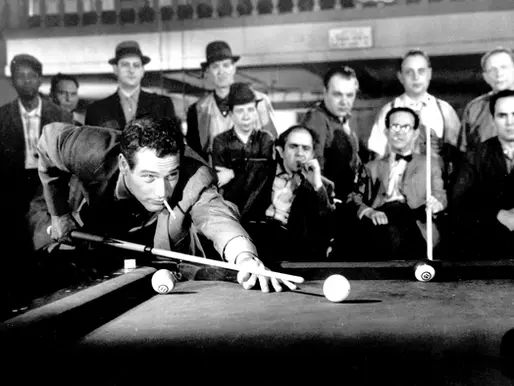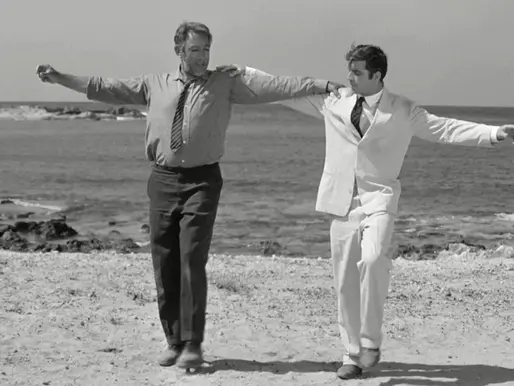top of page
Search
1960's
Classic Films from the 1960's


Birdman of Alcatraz (1962)
Released in 1962, Birdman of Alcatraz remains one of the most thoughtful and humane prison dramas in American cinema. Directed by John Frankenheimer and anchored by a towering performance from Burt Lancaster, the film transcends its genre to explore profound questions of redemption, isolation, and the indomitable human spirit.

Soames Inscker
6 min read


The Train (1964)
Released in 1964, The Train is one of the most compelling and intelligent war films ever made — a riveting blend of action, moral tension, and historical reflection. Directed by the American filmmaker John Frankenheimer and set in Nazi-occupied France during the final days of the Second World War, the film combines the technical precision of a thriller with the moral weight of a drama about art, culture, and human sacrifice.

Soames Inscker
5 min read


The Day the Earth Caught Fire (1961)
Released in 1961, The Day the Earth Caught Fire stands as one of the finest examples of British science fiction cinema — intelligent, grounded, and deeply human. Directed and co-written by Val Guest, who had already made his mark with The Quatermass Experiment, the film combines the urgency of Cold War politics with the immediacy of newsroom realism. What results is a gripping, thought-provoking disaster film that feels both of its time and eerily prescient.

Soames Inscker
4 min read


The Flight of the Phoenix (1965)
Robert Aldrich’s The Flight of the Phoenix (1965) remains one of the most compelling and unconventional survival dramas ever committed to film — a taut, psychological study of men under pressure, wrapped in a thrilling and meticulously constructed adventure.

Soames Inscker
5 min read


The Charge of the Light Brigade (1968)
Tony Richardson’s The Charge of the Light Brigade (1968) is one of the most audacious and intellectually provocative historical war films of its era. Far from being a simple retelling of the infamous cavalry charge during the Crimean War, the film is a searing, darkly satirical examination of the British class system, military incompetence, and the crumbling ideals of Victorian imperialism.

Soames Inscker
5 min read


Camelot (1967)
Joshua Logan’s Camelot (1967) stands as one of the most lavish and ambitious film musicals of its era — a sweeping adaptation of the celebrated Lerner and Loewe stage show that sought to bring the Arthurian legend to life through song, spectacle, and romance.

Soames Inscker
5 min read


The Man Who Shot Liberty Valance (1962)
The Man Who Shot Liberty Valance (1962) is not just one of John Ford’s greatest films—it is one of the most introspective and politically astute Westerns ever made. A masterful late-career work from the director who helped define the genre, the film reconsiders the mythology of the American frontier and asks hard questions about the cost of civilization, the nature of heroism, and the truth behind legend.

Soames Inscker
5 min read


The Hustler (1961)
The Hustler (1961) is more than just a film about pool—it’s a powerful, haunting character study about pride, obsession, and the elusive nature of integrity.

Soames Inscker
4 min read


La Dolce Vita (1960)
Federico Fellini’s La Dolce Vita is one of the most iconic and influential films in the history of cinema. Released in 1960, it marked a profound departure from traditional narrative and moral storytelling, signaling the arrival of a new, modernist era in European film. A kaleidoscopic journey through seven days and nights in Rome’s decadent elite society, the film is not only a portrait of a changing Italy but also a timeless meditation on meaning, excess, and the pursuit of

Soames Inscker
4 min read


The Birds (1963)
The Birds (1963) is Alfred Hitchcock’s most enigmatic and unsettling film—an apocalyptic thriller cloaked in the skin of a psychological drama. Unlike his earlier masterworks such as Psycho or Rear Window, The Birds defies easy classification. It begins like a sophisticated romantic comedy, morphs into a slow-burn psychological mystery, and then erupts into one of cinema’s most unique horror spectacles: nature turned predator.

Soames Inscker
5 min read


Night of the Living Dead (1968)
Released in 1968, Night of the Living Dead is one of the most influential horror films in the history of cinema. Directed on a shoestring budget by George A. Romero, then a 28-year-old unknown from Pittsburgh, the film redefined the horror genre, birthed the modern zombie mythos, and introduced a shocking level of graphic violence and socio-political subtext to American screens.

Soames Inscker
4 min read


The Wild Bunch (1969)
The Wild Bunch is more than just a film—it is a revolution in Western cinema. Released in 1969, directed by the controversial and visionary Sam Peckinpah, it shattered the clean-cut mythos of the Old West with a brutal, elegiac, and unflinchingly violent portrayal of aging outlaws at the turn of the 20th century.

Soames Inscker
4 min read


Once Upon a Time in the West (1968)
Once Upon a Time in the West (C’era una volta il West) is not just a film—it is a cinematic cathedral built in the mythic landscape of the American West. Released in 1968, this masterpiece from Italian director Sergio Leone marked a turning point in the evolution of the Western genre.

Soames Inscker
4 min read


That Touch of Mink (1962)
That Touch of Mink (1962) is a classic romantic comedy that captures the glossy charm and societal mores of early 1960s America. Starring the ever-suave Cary Grant and the queen of the rom-com, Doris Day, this film was a major box-office success in its time and remains a notable example of the final golden years of Hollywood’s studio-produced, screwball-influenced comedies.

Soames Inscker
5 min read


Zorba the Greek (1964)
Zorba the Greek, directed by Michael Cacoyannis and released in 1964, is a cinematic adaptation of the 1946 novel by celebrated Greek writer Nikos Kazantzakis. This poignant and spirited film remains one of the most iconic works in world cinema, largely due to its rich emotional narrative, stirring performances, and evocative use of music and landscape. Anchored by Anthony Quinn’s legendary portrayal of the exuberant Alexis Zorba, the film is a meditation on the complexities

Soames Inscker
4 min read


The Grass is Greener (1960)
The Grass Is Greener (1960) is a genteel romantic comedy with a razor-sharp wit and a star-studded cast, wrapped in a quintessentially British setting. Directed by Stanley Donen, best known for musicals like Singin’ in the Rain and Funny Face, this film adapts a popular stage play by Hugh Williams and Margaret Vyner into a charming yet subtly subversive film that examines marriage, fidelity, and class with elegant humour.

Soames Inscker
5 min read


A Kind of Loving (1962)
A Kind of Loving (1962) is one of the defining films of the British New Wave or "kitchen sink realism" era—a movement in late 1950s and early 1960s British cinema that brought working-class life, unvarnished social themes, and emotional honesty to the screen. Directed by John Schlesinger in his feature debut and starring Alan Bates in one of his earliest leading roles, the film adapts Stan Barstow’s novel with a mixture of grim realism and emotional subtlety.

Soames Inscker
5 min read


In Harms Way (1965)
In Harm’s Way (1965) is a sweeping World War II epic that blends intimate human drama with large-scale naval warfare, bringing together a powerhouse cast under the direction of Otto Preminger. With John Wayne and Kirk Douglas headlining, the film explores themes of duty, honor, loss, and redemption against the backdrop of the early years of the Pacific War, particularly around the time of the attack on Pearl Harbour.

Soames Inscker
5 min read


The Parent Trap (1961)
Walt Disney’s The Parent Trap (1961) remains a beloved classic of family cinema, notable for its engaging blend of comedy, romance, and heartwarming family themes. Featuring Hayley Mills in a groundbreaking dual role as long-lost twin sisters, the film was both a critical and commercial success upon its release and has since endured as one of Disney’s most charming live-action productions.

Soames Inscker
5 min read


Ocenas Eleven (1960)
When Ocean’s 11 premiered in 1960, it was less a film and more a cultural event. Marketed as the ultimate Rat Pack vehicle, it brought together the most charismatic entertainers of the era—Frank Sinatra, Dean Martin, Sammy Davis Jr., Peter Lawford, and Joey Bishop—for a stylish caper set against the glittering backdrop of Las Vegas.

Soames Inscker
5 min read
bottom of page


